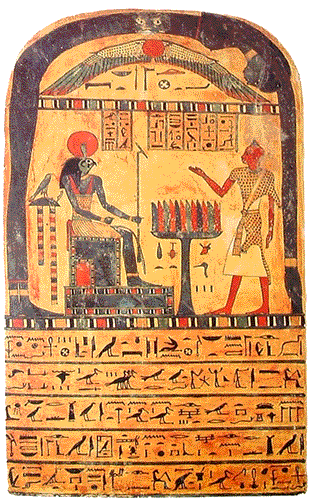
|
THE STELE OF REVEALING |

|
This essay was written by Dale R. Gowin for a college history class in 1983. |
|
The stele measures 51.5 by 31 centimeters. It is a funerary monument for Ankh-f-n-khonsu, a priest of Thebes. The obverse side depicts the priest in his characteristic role of prophet, conversing with the hawk-headed solar deity, Horus, who appears in the form of Ra-heru-khuti or Ra-hoor-khuit. Above them stretches Nut or Nuit, the goddess of the night sky, whose hands and feet touch the ground. The winged disk, identified as “Hadit, the great god, lord of the sky,” floats between the goddess and the two figures below. These illustrations are followed by five lines of hieroglyphs, which are continued with an additional eleven lines on the reverse side. The tablet comprises the essence of the cosmogony of the Egyptian priesthood and it is also a magical talisman designed to facilitate the success of the prophet Ankh-f-n-khonsu in the after-death state. Egyptian religion was intricately interwoven with magical beliefs and practices. This combination of magic and theology is technically called “theurgy,” from the Greek theos, god, and ergon, work.l Theurgy comprises rituals, incantations, and other activities by which humans can cause or influence change in the world of the gods, or bring supernatural forces to bear upon material reality. The Western mystical initiate tradition (which traces its origins to Egyptian sources through the Pythagoreans, the Essenes, the Freemasons, and similar secret societies) distinguishes “theurgy” (divine magic) from “thaumaturgy” (wonder-working or mundane magic). The hieroglyphic inscription on the obverse side of the stele contains a hymn addressed to Nuit, who is the personification of the stars of the night sky (and hence of space), and to the Solar Deity Ra-Hoor-Khuit, the Warrior who instills fear in the hearts of the other gods. The god Hadit is invoked with the epithet “winged snake of light,” a term reminiscent of the Tantric Kundalini, the cosmic energy within the human body that is personified as a fiery, winged serpent coiled around the base of the spine. The inscription on the reverse side consists of spells to aid the prophet in the judgment after death, and to assure him of powers in the afterworld, including the ability to return to Earth. “Stele 666” was produced at a time when the once great Egyptian Empire had become a shadow of its former glory. From its heights of achievement in the 18th dynasty, Egyptian culture deteriorated under the stresses of competing forces from the Hittite and Assyrian empires, economic crisis and political corruption. The Post-Empire Age, also called the Third Intermediate Period, comprised the 20th through the 25th dynasties, 1100 - 690 BC. The 25th dynasty began with the Ethiopian conquest of Egypt under Piankhi of Napata. The dynasty stayed in power until Egypt was taken in the Assyrian invasion of 671 BC. Piankhi became the first king of the 25th dynasty after successfully overcoming the short-lived 24th dynasty that had been established by Tefnakht. The deities depicted in “Stele 666” represented cosmic principles personified with human and animal characteristics. The Egyptian gods had “none of the corporeal and mundane limitations of mortal man”1, existing in a realm beyond the categories of time and space. They represented the mysterious forces of nature as they appeared to the imaginative minds of this creative and mystical culture. The goddess Nuit “who lay in a great arch over the earth”2 personified the emptiness and limitlessness of space, and the stars were considered to be the elements of which her body was composed. In a poetic paraphrase of the inscriptions on the obverse side of the stele, she is introduced:
The prophet identifies himself before the gods and invokes the supreme power of the solar warrior-lord:
In the preceding verse, the “Khu” is the soul of the magician that survives death; the “Ka” is his conscious mind; the “Khabs” is the light that illuminates the path of the spirit after death. The inscription continues with an invocation of the four manifestations of the solar deity: Ra, the rising sun; Ahathoor, the sun at noon; Tum, the setting sun; and Kephra, the sun at midnight. The invocation continues with the names of the prophet’s earthly parents:
The symbols of the stele combine to form a talisman that was believed to grant the Priest the power to transcend death through identification with the transpersonal archetypes of the supreme deities who represented the infinite stars of space and the solar flame at the core of every living being. FOOTNOTES 1. Joseph Kaster. Wings of the Falcon: Life and Thought of Ancient Egypt (NY: Holt, Rinehart & Winston, 1968), p. 35. 2. W. A. Ward, The Spirit of Ancient Egypt (Beirut: Khayats, 1965), p. 135. 3. The paraphrase of the hieroglyphs of “Stele
666” was prepared in 1904 under the supervision of Egyptologist Brugseh Bey at the
Boulaq Museum in Cairo, and it is reprinted in Aleister Crowley, The Holy Books of
Thelema (NY: Weiser, 1983). pp. 250 - 252. |